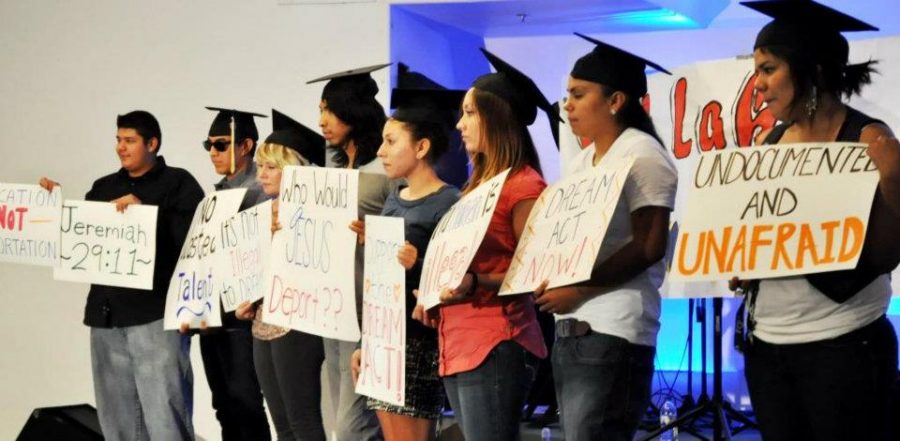Immigration in Modern America
February 12, 2020
In the past decade, immigration has increasingly become a passionate topic for American society. While immigration has certainly been on the minds of Americans for more than a decade, the intensified need for a solution in terms of undocumented immigrants has brought the discussion into the spotlight. America has become rather divided in terms of possible solutions, and tensions between differing belief groups have risen significantly. Despite the frustrations that follow the lack of a proper solution, though, is important that we reach out to the families that are already here and still struggling.
Many immigrants who come to America for a better life push their children to work hard and become an outstanding member of society. However, in a politically stormy modern-day America, becoming successful despite an immigrant status can be extremely difficult. Forest Grove High School has a migrant education program specifically for the immigrants and migrants of the Forest Grove community to assist struggling families. Ms. Najera, one of the counselors in charge of the migrant education program, expanded on the responsibilities that coordinate with her position. She explained that she helps break down language barriers for families, support these young adults with their education, communicate with families about their needs and helps find paths for these young adults who wish to continue to higher education. When asked, Ms. Najera confirmed that she has also worked with undocumented families in her program. She continued to tell the main struggles for these families, explaining that there is a lot of fear, in both the parents and the children, of deportation. This fear of discovery and a lack of knowledge about the educational paths for undocumented immigrants has led to a loss of hope in many of these young adults because they are unaware of a possible brighter future despite their undocumented status. These families also wrestle with money troubles, especially since getting a job and a license becomes an extremely tricky feat when a family does not have papers. The young adults of the family frequently end up having to work many hours a week on top of taking care of their homework and younger siblings as an attempt to help support their families. Lastly, both documented and undocumented immigrants struggle with language barriers if they come from a non-Spanish speaking country. While many residents of the U.S are bilingual, the two languages usually spoken are English and Spanish. For families coming from countries with languages other than English or Spanish, this is a strong barrier to resources that are necessary to keep families in proper living conditions and education.
Despite the multitude of challenges that face both documented and undocumented immigrants, though, success stories lie all across the United States that speak of these peoples’ determination to build a better life. An example straight from the Forest Grove community would be Ramses Verlinden, a Dutch immigrant who originally came to America as an undocumented immigrant when he was three years old. Ramses recalled moving all across the United States, Mexico, going back to Holland, and then miraculously coming back to America to grow up in California. Ramses and his family members, who also immigrated to Holland with him, were all able to gain a green card from the 1986 Reagan amnesty program. He moved to Oregon as a young man for college and soon realized his dream was to become a painting business owner, dropping out of college to devote all his time to his business. Nearly twenty years later, Ramses’s business Holland Painting is flourishing and he is an American citizen, having gotten his citizenship in the year 2006. He has become a well-respected member of the community along with his wife, Athena Phillips, who has recently opened a mental health clinic in Forest Grove.
Stories similar to Ramses’s are found in multiple communities in differing states. The New York Times searched for immigrants willing to tell their struggles as well as success, coming across Julyanna Carvahlo Rogers and Julia Verzbickis. Julyanna came to America at eleven years old with her family, trying to get treatment for her sister’s leukemia. Her sister relapsed three years later and, afraid of having to go back to Brazil if they applied for another tourist visa, they stayed in America. Now, Julyanna’s sister is a two-time cancer survivor and Julyanna lives with her family in Memphis while volunteering for the organization One Family Memphis. Julia came to America when she was nine years old with her family for the stability that their home country did not have. She grew up as an American and graduated college with a double major, then applied for Teach for America. She now lives in San Antonio with her family and is a middle school teacher. Julia and Julyanna are completely unrelated; they may not even know who the other is. However, they share something in common: their stories may not be the same, but their struggles reflect issues faced by immigrants who make the life-changing decision to come to America to pursue their dream of a better life.
In 2019 America, the population is becoming increasingly diverse. People of many cultures, races, and languages from across the world live as Americans, whether or not they are documented. While the political debate about immigrants continues to rage on, look around at those you are close to and take the time to learn their stories. America is full of beautiful people who perhaps might not have come from any state in the U.S but are still worthy of knowing regardless. The hate that can be so stark in the United States today is often bred by fear, and fear can be avoided by learning to understand one another. A difference in skin color, language, beliefs, cultures, traditions or way of dress does not undermine the humanity we all share as human beings.





















































































































































